Leopards: India

This is a collection of articles archived for the excellence of their content. |
Contents |
Attacks on and deaths of leopards
2007-18
Dr Ajay Deshmukh, Wildlife vet, Nashik, May 23, 2021: The Times of India

From: Dr Ajay Deshmukh, Wildlife vet, Nashik, May 23, 2021: The Times of India

From: Dr Ajay Deshmukh, Wildlife vet, Nashik, May 23, 2021: The Times of India

From: Dr Ajay Deshmukh, Wildlife vet, Nashik, May 23, 2021: The Times of India
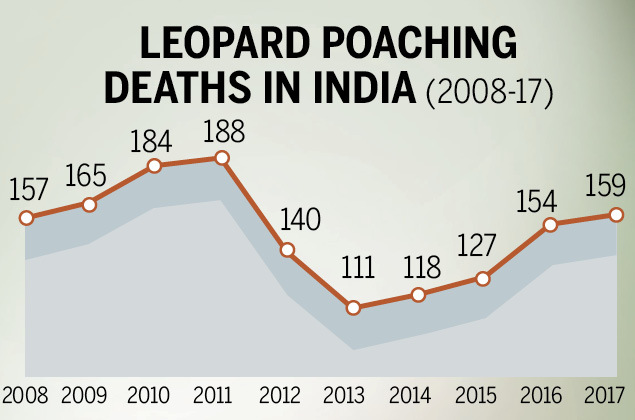
From: Dr Ajay Deshmukh, Wildlife vet, Nashik, May 23, 2021: The Times of India

From: Dr Ajay Deshmukh, Wildlife vet, Nashik, May 23, 2021: The Times of India
At least one leopard dies in India every day — that’s the grim reality that threatens the country’s leopard population. While conservation efforts have begun showing results for tigers, poaching and man-animal conflict still pose risks to the spotted cat.
India has around 7,701 leopards living around tiger habitats, with the maximum numbers in Madhya Pradesh, followed by Karnataka and Maharashtra, according to data from a 2015 census, which was carried out in 13 states and reports extrapolated figures. The actual number of leopards though is estimated to be higher at around 12,000 to 14,000 as leopards are also present in other states.
Sadly, deaths have been rising each year — from 301 in 2014 to 460 in 2018. Seventy four leopards that died last year were killed in either train or road accidents.
The highest mortality rate of 93 in 2018 was recorded in Uttarakhand. As recently as on August 2 this year, four leopards were found dead at the Rajaji Tiger Reserve and the Shivalik Forest Circle in the state. According to S Satya Kumar, an expert studying the man-animal conflict in Uttarakhand, "The numbers sound alarmingly dangerous."
LEOPARD PARTS IN HIGH DEMAND
Southeast Asia is a big hub for leopard body parts. The big cat's skin, claws and bones are in high demand in this region, where they are used to perform black magic rituals. Sent from various parts of India, these parts ultimately land up in Chinese markets.
CONFLICT WITH HUMANS
Compared to its cousins — the lion and tiger — the leopard has the most extensive habitat. While the others largely limit themselves to core forest areas, leopards often cross a forest zone into human settlements in search of easy prey like livestock or stray dogs.
The animal is a versatile, opportunistic hunter. It has a very broad diet. Due to this, it is spread uniformly across a forest range, but prefers the periphery where easy prey can be found near human habitats. Prey can include adult humans and even children, if they are near the forest. Human-animal conflict often results when people try to save pets, strays or themselves. Experts stated that most such attacks on humans are “accidental”.
Conservation efforts need to be strengthened to ensure that the Indian leopard, despite being listed as 'vulnerable' and on the IUCN Red List — protected under Schedule I of the Wildlife Protection Act, 1972 — no longer remains ignored.
Major causes
Poaching
Most leopard deaths are due to poaching as evident from the seizures of leopard hides and body parts. Naturally, this make it a big concern for conservationists across the globe. In 2018, 155 leopards were hunted or poached across India. According to the Wildlife Protection Society of India (WPSI), poaching claimed the lives of 57 leopards in the first four months (Jan-April) of 2019.
Accidents
One of the chief reasons for leopard deaths in India. Last year, 74 leopards lost their lives in accidents. Most such accidents happen inside national parks and wildlife sanctuaries. Electricity poles, fences, railway tracks, roads within sanctuaries have been hotspots for accidents.
Attacks by villagers
Between 2011 and 2017, there have been more than 2 lakh human-animal conflicts in Maharashtra alone. Parks that house wild animals are set up on land near villages and some villagers are relocated too close to wildlife sanctuaries. Humans wandering into sanctuaries and reserves often meet a deadly fate. In response, villagers kill wild animals. At times, animals wander off into villages and villagers kill them in self-defence.
Actions of forest department
This one’s a debatable issue that includes ‘death in custody’ and death due to intervention by forest officials. While most would initially question the forest department’s intentions, in most cases, the intervention was necessary. In 2018, nine deaths occurred due to the forest department’s action.
Natural causes
In 2018, 194 deaths were caused by natural or other reasons, including natural hunting order, old age, illness and territorial fights. Conservationists have questioned forest department’s efforts and asked how such deaths can be prevented. But, the fact is that natural and other factors do contribute to leopard deaths.
2011: Guidelines for leopard-human conflict
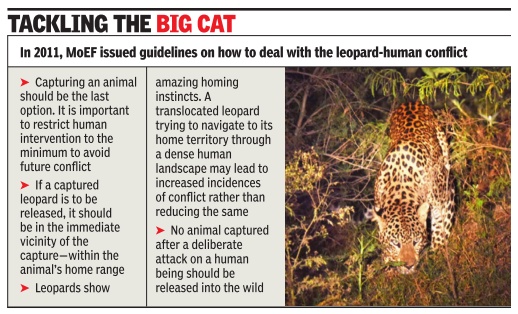
Please see graphic:
MoEF’s 2011 guidelines on how to deal with the leopard-human conflict
2015-18: 260 leopards poached
Shiv Sahay Singh, '260 leopards poached since 2015’,December 26, 2018: The Hindu

From: Shiv Sahay Singh, '260 leopards poached since 2015’,December 26, 2018: The Hindu
Uttarakhand, Himachal Pradesh accounted for the largest number of cases, MoEFCC tells Lok Sabha
At least 260 leopards were poached in the country between 2015 and 2018, with Uttarakhand accounting for 60 cases and Himachal Pradesh reporting another 49, according to information given to Parliament by the Ministry of Environment, Forest and Climate Change (MoEFCC).
Of this, 64 cases of leopard poaching were recorded in 2015, 83 in 2016, 47 in 2017 and 66 till October 2018, the data tabled in the Lok Sabha show.
Central Indian States like Chhattisgarh and Madhya Pradesh also recorded a high number of cases of leopard poaching in the past four years, at 25 and 21 respectively. Poaching of leopards was reported by 19 States including Assam and West Bengal in the east, Punjab in the West and Telangana and Tamil Nadu in the south.
'260 leopards poached since 2015’
Replying to a question by BJP MP Rattan Lal Kataria, the MoEFCC said the figures had been compiled from data furnished by State enforcement agencies as the management and protection of wildlife, including leopards, is primarily the responsibility of States and Union Territories. It added that information on the killing of leopards by villagers was not collated by the ministry.
Wildlife organisations, however, estimate leopard poaching to be at a much higher level based on the seizures of body parts. According to the Delhi based Wildlife Protection Society of India, 163 cases of poaching and seizures of body parts were recorded in 2018, an increase from 159 in 2017.
Experts point out that since leopards live in close proximity to human habitation and are found all across the country, the cases of leopard poaching too are spread countrywide with a significant number of such incidents not showing up in government records. There are also several incidents of leopard deaths on account of road kills, particularly in States such as Maharashtra and Karnataka.
Vidya Athreya, an ecologist at Wildlife Conservation Society who has worked on the human-leopard conflict, stresses on the need to evolve proactive policy measures for ensuring the protection of wild animals like leopards that live outside protected areas.
2018: 93 leopards dead in 2 months
Vineet Upadhyay, 93 leopards dead in 2 months of 2018, March 6, 2018: The Times of India
Environmentalists and wildlife experts said they were alarmed by a new study which has reported 93 leopard deaths — a very high number — from across the country in just the first two months of 2018.
Most of the big cats were poached for their skin and other body parts. Uttarakhand topped the list with 24 leopard deaths, followed by Maharashtra (18) and Rajasthan (11).
Incidents of leopard deaths were reported from 18 states in all. According to the Wildlife Protection Society of India (WPSI), which compiled the data, most leopard deaths were due to poaching as evident from seizures of leopard hides and body parts. Only 12 of the big cats died of natural causes. WPSI said there were 23 cases in which hides, skulls and claws were seized.
WPSI said of the leopards killed, eight were run over by vehicles or trains in January and February while five were killed by villagers and seven in fights with other leopards. One was shot dead by a police official in Lucknow.
Even though the Indian leopard is listed as “vulnerable”, it largely remains ignored in terms of conservation efforts. Leopard deaths — some 131 died last year in the same time period — have begun to assume alarming proportions.
Population
80% decline in 20th-century
The Times of India Apr 06 2015
Seema Sharma
Leopard count down by 80%: Study
Fast shrinking habitat bringing them in conflict with humans: Scientists
Trashing speculation following the spate of recent incidents of humanleopard conflict which indicated that leopard numbers were on the rise, a study conducted by three wildlife scientists has found that the leopard population in the country, on the contrary , has declined by a whopping 7080% over the past 100 years.
The study , conducted over four years by Samrat Mondal of the Wildlife Institute of India (WII), Krithi K Karanth of the Wildlife Conservation Society, and Uma Rama Krishnan of the National Centre for Biological Sciences (NCBS), has been sent to wildlife journals for review.
Talking to TOI, Mondal said that the study was primarily based on genetic data analysis. “The population estimation of leopards has been done in different parts of the country but no cumulative data is available. We collected molecular data from fecal samples of leopards, and took into account depletion of their habitat as well as prey range over the past 100odd years. When we analysed the data, we found an almost 70-80% decrease in the prevalence of leopards.“
In India, leopard conservation is often clubbed with tigers because many leopards are in tiger reserves. But be cause a reliable count of their numbers is not available, not much has been done for their systematic protection.
“Tigers have got protection under the Project Tiger program, following which poachers have now started replacing tiger body parts with those of leopards. Around 4,000 body parts and bones of leopards were recovered in the period 1994-2013, compared to 1,000 body parts of tigers,“ said Mondal.
Rising instances of conflict with humans is also impacting the big cats. “Severe depletion of habitat and prey is bringing leopards in direct conflict with humans,“ said AK Singh, senior scientist with the World Wide Fund for Nature, Uttarakhand.
Accentuating the problem, Mondal says, is the fact that leopards are territorial animals and solitary by nature. “Because their territory is getting encroached, instances of conflict are on the rise, which in turn is affecting their population.“
Report said 28, but Odisha claims it has 60 tigers
The wildlife wing of Odisha's forest department has courted controversy by claiming that the number of big cats in the state is around 60. The All India Tiger Estimation Report, 2014, released in January 2015 by the Wildlife Institute of India, reported a fall in tiger population to 28 from 32 in 2010 and 45 in 2006 in the state. “The tiger population will be around 60. We will be able to make it official after WII endorses the additional inputs,“ the principal chief conservator of forest said.
2014 census
The Times of India, Sep 07 2015
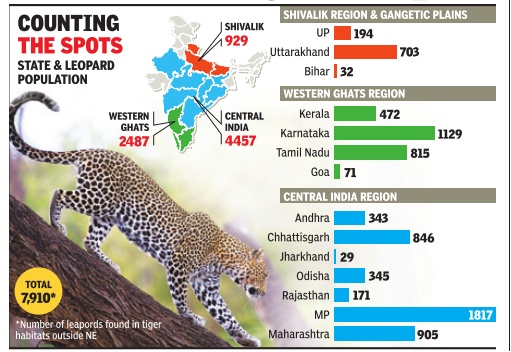
Amit Bhattacharya
For first time, India gets a count of its leopards: 12,000-14,000 India finally has an estimate of its most populous large predator, the leopard. The first count of India's leopards, conducted alongside last year's tiger census, has put the spotted cat population at 7,910 in and around tiger habitats across the country , except the northeast. The leopards were counted using the same methods adopted for the tiger census, which involved getting pictures of animals through camera-trapping and gathering other evidence of their presence, and then extrapolating the numbers to cover the entire forest landscape.
“There are leopards out side the areas we covered...we estimate India's total leopard population to be 12,000 to 14,000,“ said Yadvendradev V Jhala, lead scientist of the tiger census, who presented the leopard figures at Wildlife Institute of India's annual research seminar in Dehradun last week. The maiden count of In dia's leopards has pro vided the first accurate picture of the density and distribution of the spotted cats, which were earlier guesstimated to be anywhere between 10,000 and 45,000.
The exercise covered 3,50,000 sq km of forested habitat across the Shivalik hills and Gangetic plains, central India and the Western Ghats.As many as 17,143 pictures of 1,647 individual leopards were obtained during the exercise that covered most forested landscapes, even the low-grade revenue forests.
The study found the species well distributed across the country, indicating that India's leopard population is “quite healthy“.
“Most of the leopard populations are contiguous, ensuring a healthy genetic exchange. So, leopards do not face the problems of isolated populations that plague Indian tigers,“ Jhala told TOI.
The wildlife biologist said since there were no previous estimates, there was no way of knowing whether the leopard population was growing or declining. “But leopards are doing far better than tigers because they can survive in scrubs and humanimpacted forests as well.That's why they are not in imminent danger as the tigers,“ he said. However, healthy forests remain crucial to the long-term survival of leopards in India, he noted.
2016/ Orissa: numbers increase
Wildlife enthusiasts have some reason to cheer. Though the recent tiger census in Jeypore forest division drew a blank, the team spotted at least five leopards, a jump of four since the last headcount in 2013-14. The six-day census began on February 5 and 318 employees of the forest department participated in it. According to forest officials, two leopards were spotted near Bichalkota under Jeypore forest range and three more at Boipariguda forest range. "To capture pug marks of animals, pressure impression pads were put up at several places. These were sent to the office of principal chief conservator of forests (wildlife), which confirmed presence of five leopards, two among them female, in the forest division," said DFO (Jeypore) A K Kar. He didn't rule out presence of more leopards in the forests under the division. To track the movement of animals, the department has decided to install 10 camera traps in areas frequented by them and near waterholes. "We have identified some areas in Jeypore and Borigumma forest ranges, where these cameras will be installed. They will also help confirm presence of more leopards in the forest division," the DFO said. Spread over 1,199 sq km, the forest division comprises Jeypore, Boipariguda, Kundura, Kotpad, Borigumma and Gupteswar forests ranges and shares borders with forests in Chhattisgarh.
2017/ Sahibabad: leopard in an urban area
Abhijay Jha, The Times of India, April 8, 2017
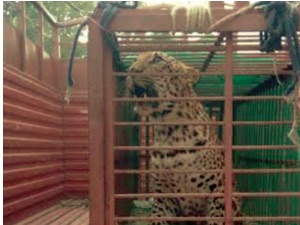
GHAZIABAD: A full grown male leopard was rescued from a house in Bhopura's Krishna Vihar Kuti, in Sahibabad area in the wee hours of Friday but not before injuring two people.
The leopard was first spotted in the residential area on Thursday night at around 9 pm creating panic among residents. In a bid to escape, the leopard somehow entered a house and was confined in a room when an alert resident locked it from outside. Soon forest department officials reached the spot and cordoned off the area by placing a net around all possible exits.
"I had just returned from office and was parking my bike when I suddenly noticed a leopard which attacked me" says Bittu, 32. "The leopard sunk his teeth in my arms and chest but I managed to shrug it off and it ran away" adds Bittu. He was rushed to GTB Hospital where first aid was administered, he was discharged later. The leopard then made its way into the house of one Satpal whose twenty-one-year-old daughter Preeti fled to the terrace when she saw the animal approaching. "I noticed it approaching and raced towards the terrace while shouting "tendua ghus aaya hai" says Preeti. "Hearing me some people gathered and locked the room where the animal had entered and informed police and forest department officials" adds Preeti.
Anup Singh, circle officer Sahibabad said, "We reached the spot shortly after we were informed of a leopard sighting but since the animal was locked in a room we were not in a position to say whether it was a leopard or fishing cat or some other animal. When a team of forest officials arrived, it cordoned off the area by placing a net and it was only at round 4 am that forest officials confirmed that it is actually a leopard" adds Singh.
Forest Range Officer Asif Shehzad meanwhile said, "It is a full grown male leopard and a team of officials were summoned from Meerut and the animal was tranquilized in the early hours of Friday. It was transported to Shivalik-Saharanpur forest range and was set free."
BP Singh, District Forest Officer meanwhile said, "The leopard must have strayed from the nearby Hindon Air Force forest area either in search of food or must have lost its sense of direction. I feel that members of the cat family have this tendency of losing sense of direction in an overcast condition and this leopard may have wandered in a residential area because of this very reason."
There have been instances of leopard sightings in the past in Ghaziabad and adjoining districts as it is their natural habitat which is provided by thick foliage around flood plain areas of Yamuna and Hindon.
2018: leopard population; 2014-18: deaths

2014-18: leopard deaths
From: August 27, 2019: The Times of India
See graphic:
2018: leopard population, state-wise;
2014-18: leopard deaths
2018
December 21, 2020: The Times of India
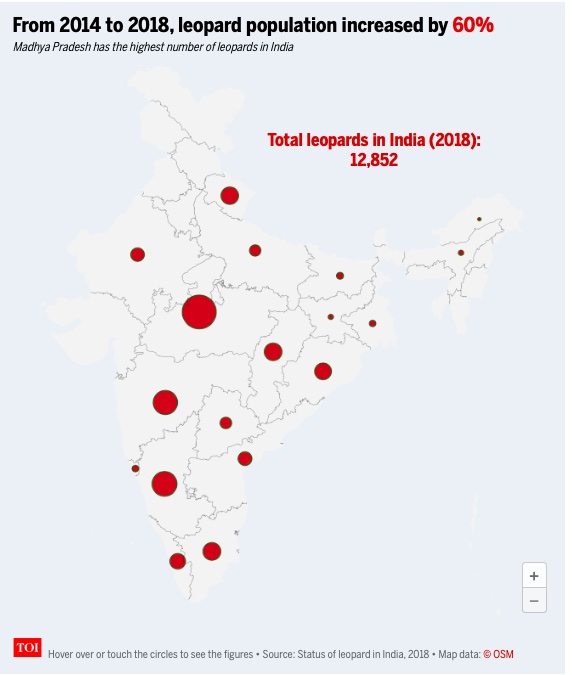
From: December 21, 2020: The Times of India
India's leopard population increases by 60% in 4 years
NEW DELHI: India's leopard population increased to 12,852 in 2018 from around 8,000 in 2014, environment minister Prakash Javadekar said on Monday. The minister was releasing the ‘Status of Leopards in India 2018' report.
The minister asserted that the rise in leopards' numbers, coming on the heels of similar reports on tigers and lions, shows that the country is protecting its ecology and biodiversity well.
Here are the key points from the report:
The leopard population has been estimated using camera trapping method.
There are 12,852 leopards in India as of 2018, an increase of 60% since 2014.
The highest concentration of the leopard in India is estimated to be in Madhya Pradesh (3,421) followed by Karnataka (1,783) and Maharashtra (1,690).
Recent meta-analyses of leopard status and distribution suggest 48–67% range loss for the species in Africa and 83–87% in Asia. In India, leopards have experienced a possibly human-induced 75-90% population decline in the last ~120-200 years.
In Indian subcontinent poaching, habitat loss, depletion of natural prey and conflict are major threats to leopard populations.
All these have resulted in changing the species status from ‘Near Threatened’ to ‘Vulnerable’ by the International Union for Conservation of Nature (IUCN).
As for region-wise distribution, the highest number of 8,071 leopards were found in central India and eastern ghats, which include the states of Madhya Pradesh, Maharashtra, Rajasthan, Odisha, Chhattisgarh, Jharkhand, Telangana and Andhra Pradesh.
In the western ghat region, which comprises Karnataka, Tamil Nadi, Goa and Kerala, there are 3,387 leopards.
There are 1,253 leopards in Shivalik and Gangetic Plains which includes Uttar Pradesh, Uttarakhand and Bihar.
In the northeast hills, there are just 141 leopards.
(With inputs from agencies)
2020: no clarity on numbers
India lost 364 leopards this year — of how many, no one knows for sure. There was a census in 2014, which came up with a wide range of 12,000-14,000. Then there was one in 2018, findings of which no one knows yet. The manleopard conflict, meanwhile, has become more complex — 29 times this year, people decided to “eliminate” a leopard themselves. Conservationists say the two are related — with little information on where leopard populations are spread, not much can be done to prevent conflict and, consequently, help conservation.
“In many regions, leopards are perceived as pests and eliminated due to their conflict with humans,” a recent study by global wildlife trade monitoring network TRAFFIC said. “While the plight of the tiger is renowned, the leopard is suffering in its shadow.”
The government says it is doing its bit. “We are liberally giving out funds for conservation of leopards as they are on the government’s list of 21critically endangered species,” said Soumitra Dasgupta, inspector general of forests (wildlife), ministry of environment, forests and climate change.
The mortality rate of leopards is recorded by the Wildlife Protection Society of India. But any strategy to protect them has to start with finding out how bad the situation is. And for that, the numbers are not there. Like the 2018 leopard count, which never published the findings. “The count is done by WII (Wildlife Institute of India) as we conduct the tiger estimate. Any kind of wildlife estimate is a vast and evolving exercise.... We are soon going to develop scientific protocols,” said Dhananjai Mohan, director of WII.
But even during the count, a blind spot emerged — leopards don’t inhabit just reserves but are found sharing landscapes of all kinds. And that is where conservation efforts seem to have fallen through lately. What has been missing is enough “space” for leopards and because of that, the run-ins with human populations keep happening. It’s a cyclical problem. Vidya Athreya, biologist at the Centre for Wildlife Conservation, said, “The most important problem is the impact of the interaction between leopards and people — livestock destroyed, attacks. It is important that we focus on reducing this conflict before anything else is done.”
2022
March 1, 2024: The Times of India
New Delhi: India’s leopard population has increased by 1,022 (nearly 8%) in four years —from 12,852 in 2018 to 13,874 in 2022. The latest assessment report however shows that the number has declined in certain states, like Chhattisgarh, Uttarakhand, Kerala, Odisha and Telangana, reportsVishwa Mohan.
The actual number may be a bit higher as the estimates represent just around 70% of the leopard habitat as the Himalayas and semi-arid parts of the countrywere not sampled.
This fifth such assessment cycle conducted a foot survey spanning 6,41,449 km to estimate carnivore signs and prey abundance. Camera traps were strategically placed at 32,803 locations, resulting in a total of 4,70,81,881 photographs that captured 85,488 photos of leopards.
Calling rise in leopard population “great news”, PM on X said, “This significant increase in leopard numbers is a testament to India’s unwavering dedication to biodiversity.”
Reserves
Jhalana
2017- 2022
Ajaysingh Ugras, February 5, 2023: The Times of India

From: Ajaysingh Ugras, February 5, 2023: The Times of India
At Jhalana, a dense forest area in the middle of Jaipur, nothing beats watching a leopard stalk up a tree, and stretch and drape itself across a branch. Similar sightings have become common amid the granite rocks of the Jawai Bandh region in Pali district.
With the possibility of leopard sightings rising to almost 90% in its forest areas, Rajasthan – a state known for tiger safaris at Sariska and Ranthambore – has found a new tourist attraction, and wildlife lovers, both domestic and foreign, are coming to it in hordes.
Spotlight On Jhalana
From film stars to cricketers, politicians and business tycoons, all are visiting Rajasthan to have a glimpse of leopards in the wild. Jaideo Rathore, a travel agency owner who runs a boutique hotel on the fringes of Jhalana, says, “Excellent sightings of leopards in the wild have made Jhalana a must-visit. Because it’s economical and has many stay options, a lot of travel agents are promoting Jaipur as a three-night destination, with a wildlife tour. ”
Data shows wildlife tourism in Rajasthan has grown rapidly over the past five years, at an yearly rate of 15-20%. The forest department’s statistics show 28,224 tourists visited Jhalana from April2022 to January 2023. So, at a time when leopards have lost up to 75% of their historical habitat, the Jhalana forest inspires hope as a conservation area. “Rajasthan was the first state in the country to initiate ‘Project Leopard’ and start effective monitoring at Jhalana,” says State Board for Wildlife member Dhirendra Godha.
Besides leopard and forest conservation, the project generates employment, he says. Taking a cue from the project, many new forest areas are being prepped for safaris “as these support the local economy as well”.
Private Safaris
There is no official record of the number of tourists coming to Jawai Bandh Leopard Reserve as safaris here are organised by private operators, but its popularity can be gauged from the stream of celebrity visitors. “Sachin Tendulkar often visits Jawai and Jhalana. Bollywood couple Vicky Kaushal and Katrina Kaif also recently chose leopard country Jawai to celebrate the new year. These celebrities are making leopards popular,” says Vishwaraj Singh Asop, who organises adventure tours in the Jawai Bandh region. Jawai was also featured in a recent web series on Netflix. The tourism department’s records show 43 resorts and homestays have sprung up around the Jawai Bandh Leopard Reserve in the last five years.
Conservationists are concerned over the growing popularity of these destinations, and want the government to regulate tourism and construction of resorts in these areas. Bina Kak, a former minister for tourism, environment and forests, says, “At Jawai, the forest department should deploy patrolling vehicles to monitor tourist vehicles, as many are violating the norms and getting away unchecked. A policy should be framed for allowing construction of resorts. My constituency is Sumerpur and the Jawai project was initiated during our government’s tenure to provide employment to locals. It has borne fruit. Now strict regulations are required to keep it sailing. ”
More In The Works
Buoyed by the success of leopard safaris at Jhalana and Jawai, the Rajasthan forest department is developing at least three more leopard safaris at Nahargarh in Jaipur, Khetri in Jhunjhunu and Jaisamand in Udaipur. A senior forest official said, “As leopard now shares the spotlight with the tiger, more safaris in different parts of the forest block are in the offing. There is no official record of the leopard population in Rajasthan, but it is expected that the state houses more than 500 of these big cats. ”
Recently, safaris were started in Amagarh forest block of Jaipur. The project aims to protect urban jungles or areas near a leopard population, and peaceful coexistence of humans and the big cats.
Species sighted
Pink leopard-/ 2021
Claude Dsouza, Nov 10, 2021: The Times of India
In a first, rare pink leopard sighted in Rajasthan
UDAIPUR:In a first in India, the rare ‘pink’ leopard was recently sighted in Ranakpur region, located in the Aravalli hills of south Rajasthan. Earlier sightings of the pink leopard were reported in South Africa in 2012 and 2019.
Locals in Ranakpur and Kumbhalgarh claimed to have occasionally spotted the big cat — having a strawberry-coloured coat — in various regions because of the vast stretch of forest area the pink leopard has been venturing into, Rajsamand DCF Fateh Singh Rathore said. It was only recently that photographers got a chance to capture the female leopard on camera. “As conservator of wildlife, we aim to protect the leopard by restricting human invasion into its territory,” Rathore added. The Kumbhalgarh forest area spans over 600sqkm.
Indian leopards normally have tawny coats with black spots. The pink leopard, however, has reddish-brown skin and distinctly different spots as compared to common leopards. The strawberry-coloured coat of the pink leopard is caused by erythrism — a genetic condition that either causes an overproduction of red pigments or underproduction of dark pigments — retired forest officer Dr Satish Sharma said.
Udaipur-based wildlife conservator and photographer Hitesh Motwani claimed to have captured photographs of the rare pink leopard after a fourday search. Motwani said the female leopard is aged around five to six.
The spotting of the pink leopard in the region is a matter of pride as well as concern, said wildlife conservationist and WCCB member Anil Rodgers.
See also
Leopards: India
A 'Search’ of the word ‘leopards’ on Indpaedia will lead to several other articles as well.